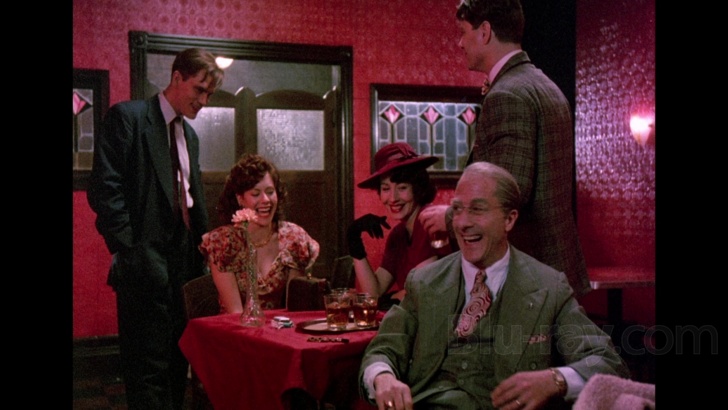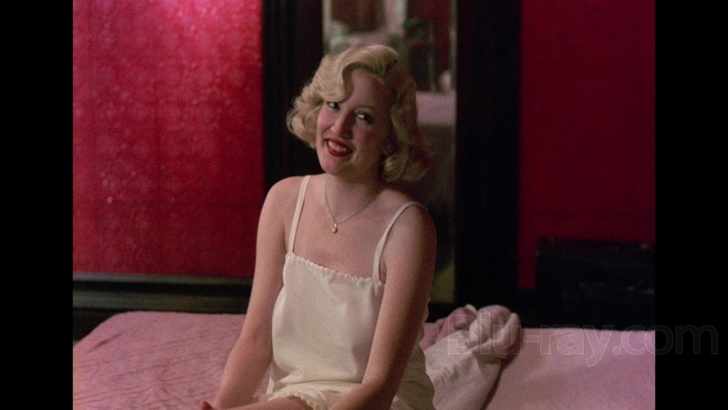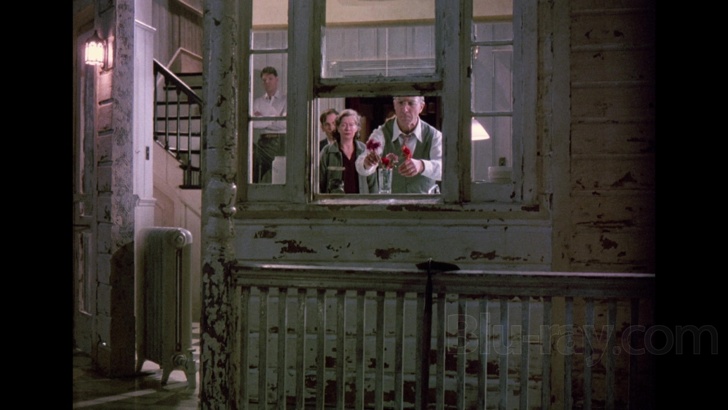Death of a Salesman Blu-ray Movie
HomeDeath of a Salesman Blu-ray Movie 
Shout Factory | 1985 | 136 min | Rated PG | Nov 15, 2016
Movie rating
6.8 | / 10 |
Blu-ray rating
| Users | 0.0 | |
| Reviewer | 3.0 | |
| Overall | 3.0 |
Overview
Death of a Salesman (1985)
Embittered traveling salesman Willy Loman, who's forced to dispense with delusions of success and come to grips with his failed career, encroaching senility and a disintegrating family.
Starring: Dustin Hoffman, Kate Reid, John Malkovich, Stephen Lang, Charles DurningDirector: Volker Schlöndorff
| Drama | 100% |
Specifications
Video
Video codec: MPEG-4 AVC
Video resolution: 1080p
Aspect ratio: 1.42:1
Original aspect ratio: 1.33:1
Audio
English: DTS-HD Master Audio 2.0 (48kHz, 24-bit)
Subtitles
English SDH
Discs
Blu-ray Disc
Single disc (1 BD)
Playback
Region A (B, C untested)
Review
Rating summary
| Movie | 4.0 | |
| Video | 2.5 | |
| Audio | 3.0 | |
| Extras | 3.0 | |
| Overall | 3.0 |
Death of a Salesman Blu-ray Movie Review
Reviewed by Dr. Stephen Larson August 21, 2020Arthur Miller's 1949 play Death of a Salesman is one of those classic literary works that was always required reading in high school. I read it, not in an English Lit class, but a Communications class in the ninth grade. My teacher also screened Volker Schlöndorff's 1985 TV production, which Miller adapted for the small screen. I remember in class discussion the major point that Willy Loman, the play's main character, was prone to contradicting himself. In revisiting this telefilm twenty-six years later, that point came back to me in the first reel when Willy (Dustin Hoffman) initially complains that his failing son, Biff (John Malkovich), acts too lazy, only to repudiate that criticism moments later.
After Hoffman completed Tootsie (1982), he was searching for good scripts (which were sorely lacking) and had a chance conversation with Arthur Miller, his Connecticut neighbor, about appearing in a revival in Death of a Salesman. Hoffman inquired about which part and Miller told him Willy, which Hoffman thought was unrealistic for him to portray. Burly Lee J. Cobb had first played it on the stage to great acclaim and was nicknamed the Walrus. Miller originally intended the lead protagonist for a smaller man like Hoffman so he reinserted his first nickname of Shrimp. Death of a Salesman was the first play Hoffman ever read and proclaimed it the work that most convinced him to become an actor. His performance as Willy on the stage was an astounding success. The New York Daily News chronicled that the Broadway opening on March 29, 1984 was greeted with highly favorable reviews. When it closed on November 18 of that year, the cast had delivered 158 performances and nine previews. Hoffman performed the role of Willy Loman some 250 times and that includes two runs in New York as well as stage performances in Chicago and Washington, according to the Los Angeles Times' Charles Champlin.

A family outing with the sons.
CBS put up $750,000 to bankroll the play as a major TV movie. Hoffman mistook Volker Schlöndorff as István Szabó when he told the former how much he enjoyed the latter's Oscar-winning Mephisto (1981). Schlöndorff had also won an Academy Award (for 1979's The Tin Drum) and was hired to direct. Death of a Salesman was shot on film aboard a large soundstage at the Kaufman Studios in Astoria, which is located in a historic filmmaking section in Queens, New York. Every actor reprised his or her role on Broadway except David Huddleston, who played Willy's neighbor and only friend, Charley. Charles Durning, a friend of Hoffman's, replaced him in the telefilm.
A lot of ink has been spilled on Death of a Salesman ever since Miller's play first went to press so I'll keep my commentary brief. Re-watching the '85 production on Blu-ray is a slow burn until Schlöndorff opens up the crammed Loman home in Brookly to other scenic locales, including the family yard where Biff practiced football in his teen years (Screenshot #11). Miller and Schlöndorff adopt a device that Peter Shaffer used successfully when adapting his own play, Equus, for the big screen. Like Alan Strang (Peter Firth) in Sidney Lumet's film version, Willy peers into a mirror that becomes a portal into his past. Miller and Schlöndorff incorporate several flashbacks through use of the mirror. The audience sees some of Willy's affairs and struggles with his two sons. Additionally, the filmmakers use Ben Loman (Louis Zorich), Willy's more successful brother, as a ghostly figure for Willy to confide in during his troubles.
TV critics lauded Death of a Salesman (1985) as a near-masterpiece when it first aired. They emphasized that while it adhered to the fidelity of Miller's original text, it wasn't a facsimile of the Broadway hit. Richard Christiansen of the Chicago Tribune observed that it's "probably as close to a complete presentation as television can offer." The AP's Michael Kuchwara previewed his readers with this caveat: "what viewers will see for three hours Sunday night on CBS is not a carbon copy of the play seen in Chicago, Washington and New York. The television version, done with most of the Broadway cast, is not simply the play transferred intact to the small screen or a movie that tries to open up the drama in realistic terms." Single words and pauses were eliminated. Cinematographer Michael Ballhaus frequently employed close-ups. While production designer Tony Walton didn't build certain sets with a roof, there's no artificiality in Miller's dialogue. His words are where the realism lies in telling one of the most poignant tales about the dissolution of the American Dream.
Death of a Salesman Blu-ray Movie, Video Quality 

Shout Select has brought Death of a Salesman to Blu-ray on this MPEG-4 AVC-encoded BD-50. The movie appears in an aspect ratio of about 1.42:1, which shows more information on each side than the originally broadcast 1.33:1 ratio. Fortunately, the image does not look horizontally stretched. The 2001 Umbrella Entertainment PAL disc, 2003 Image Entertainment DVD, and 2009 In2film (UK) DVD all were displayed in 1:33:1. The picture is very soft and often dark. The red velvet walls (Screenshot #s 2 & 7) and table cloths (capture #1) provide the only vibrant hue in the whole picture. Colors are purposefully desaturated and have a washed-out tone to them. Black levels are reasonably deep. There are a high number of white speckles during the first forty-five minutes. During the last hour and twenty minutes, they diminish in number and frequency. Had the speckling kept up, I would have lowered my score to 2.00/5.00 (or lower). Shout has encoded the central feature with an average video bitrate of 29999 kbps.
Shout has presented its scene selection popup menu, which has ten chapters, into "Two Acts and a Requiem" which is the narrative structure of Miller's play.
Death of a Salesman Blu-ray Movie, Audio Quality 

Shout supplies the TV broadcast's original monaural sound as a DTS-HD Master Audio Dual Mono mix (1888 kbps, 24-bit). Due to the age of the recording, it sounds rather flat but any analog anomalies haven't been carried over on this digitally transferred lossless track. Death of a Salesman is heavy on dialogue so it's nice to have the trusty optional English SDH, although I didn't really need to switch them on much. Hoffman had a bit part as Mumbles in Dick Tracy (1990) and he occasionally mumbles or mutters at a lower register as Willy Loman, too. I turned up the volume during those instances. Alex North brought back the original score he wrote for the stage. It evokes the Loman tragedy with somber woodwinds. Overall, this is a decent sound mix without noticeable issues.
Death of a Salesman Blu-ray Movie, Special Features and Extras 

- Private Conversations (1:21:19, 1080i) - Producer/director Christian Blackwood's documentary of the behind-the-scenes filming of Death of a Salesman won the grand prize in Documentary Competition at the eighth annual United States Film Festival, which was sponsored by Sundance. The camera follows the actors and crew around for the three weeks of filming in Queens. We hear from writer Arthur Miller, director Volker Schlöndorff, and other crew members as well as actors. Dustin Hoffman contributes some autobiographical monologues while in silhouette. At other times when the camera is behind without him fully knowing its rolling, Hoffman also discusses the day-to-day commercial costs of making films in Hollywood. This is a very revealing look at the playwright, star, and director. In English, not subtitled.
Death of a Salesman Blu-ray Movie, Overall Score and Recommendation 

Death of a Salesman became a lifetime labor of love for Arthur Miller and a passion project for Dustin Hoffman. Both Miller and Hoffman had fathers who were salesmen so there's a personal family undercurrent in the production. Shout Select has not restored CBS' telefilm but the transfer looks better than its DVD predecessors based on my research. Private Conversations has been available on SD discs before so it's good that Shout licensed and included it here. I would have liked to hear recent interviews with Schlöndorff, Hoffman, and Malkovich about this landmark TV movie. I also want to see Sony release Laslo Benedek's 1951 version, which stars Fredric March, on high-def. The Shout package is an average disc but I still RECOMMEND it.
Similar titles
Similar titles you might also like

Inside Daisy Clover
Warner Archive Collection
1965

Factory Girl
2006

A Star Is Born
2018

Brighton Beach Memoirs
1986

Once Were Warriors
1994

God's Pocket
2014

Empire of Light
2022

The Madness of King George
1994

Educating Rita
1983

Pink Floyd: The Wall
1982

Her Smell
2018

The Private Lives of Pippa Lee
2009

The Boys in the Band
1970

Olive Kitteridge
2014

The Entertainer
1960

The Public
2018

Backbeat
1994

Rudderless
2014

Shine
1996

Bee Gees: One Night Only
1997